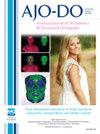How environmentally friendly is the disposal of clear aligners? A gas chromatography-mass spectrometry study
IF 2.7
2区 医学
Q1 DENTISTRY, ORAL SURGERY & MEDICINE
American Journal of Orthodontics and Dentofacial Orthopedics
Pub Date : 2025-01-01
DOI:10.1016/j.ajodo.2024.08.011
引用次数: 0
Abstract
Introduction
Used clear aligner trays are often indiscriminately disposed of with general plastic waste and incinerated. This study aimed to analyze the smoke composition from incinerating 2 common aligner materials: glycol-modified polyethylene terephthalate (PET-G) and polyurethane.
Methods
Each of the 2 materials in triplets was thermoformed. The thermoformed trays were shredded and subjected individually to open-fire combustion, ignited using a methane torch, in a specially designed combustion chamber. The resultant smoke was collected and analyzed using gas chromatography-mass spectrometry to study its in-depth composition.
Results
A total of 20 peaks, corresponding to 20 compounds, were identified from each of the 2 material samples. O-xylene (21.06%) showed the maximum concentration in the PET-G sample, whereas 1,4-dimethyl-1,3-cyclohexadiene in polyurethane (18.88%). The first peak in the PET-G sample corresponded to benzene with a relative concentration of 5.18%. Four compounds were common to both samples: 1,4-dimethyl-1,3-cyclohexadiene; 1,3-cyclohexadiene, 2,3-dimethyl-; 1-hydroxymethly-4-methylenecyclohexane; and cyclohexanemethanol, 4-methylene-.
Conclusions
Benzene, a group 1 carcinogen, was identified in the PET-G smoke sample, whereas tetrahydrofuran, a suspected carcinogen, was found in the polyurethane sample. Some compounds were hazardous, whereas most were skin, eye, and respiratory irritants. Possible mitigation strategies include proper case selection, efficient manufacturing, direct 3-dimensional printing, and developing biodegradable materials. Clinicians can set up ‘used aligner collection points’ to ensure responsible disposal. Proper disposal guidelines and stringent regulations are the need of the hour.
透明对齐器的处理有多环保?气相色谱-质谱法研究。
介绍:用过的透明对齐器托盘经常被随意丢弃,与一般塑料垃圾一起焚烧。本研究旨在分析焚烧乙二醇改性聚对苯二甲酸乙二酯(PET-G)和聚氨酯这两种常见对齐器材料所产生的烟雾成分:方法:将 2 种材料的三联体分别进行热成型。热成型托盘被切碎,并在专门设计的燃烧室中分别进行明火燃烧,使用甲烷火炬点燃。收集所产生的烟雾,并使用气相色谱-质谱法分析其深度成分:结果:从两种材料样品中分别鉴定出 20 个峰值,对应 20 种化合物。在 PET-G 样品中,邻二甲苯(21.06%)的浓度最高,而在聚氨酯中,1,4-二甲基-1,3-环己二烯(18.88%)的浓度最高。PET-G 样品中的第一个峰值是苯,相对浓度为 5.18%。两种样品共有四种化合物:1,4-二甲基-1,3-环己二烯;1,3-环己二烯,2,3-二甲基;1-羟甲基-4-亚甲基环己烷;以及环己基甲醇,4-亚甲基:在 PET-G 烟雾样本中发现了 1 类致癌物苯,而在聚氨酯样本中发现了疑似致癌物四氢呋喃。有些化合物是有害的,而大多数是皮肤、眼睛和呼吸道刺激物。可能的缓解策略包括正确选择病例、高效制造、直接三维打印以及开发可生物降解的材料。临床医生可以设立 "废旧矫治器收集点",确保以负责任的方式进行处理。适当的处置指南和严格的法规是当务之急。
本文章由计算机程序翻译,如有差异,请以英文原文为准。
求助全文
约1分钟内获得全文
求助全文
来源期刊
CiteScore
4.80
自引率
13.30%
发文量
432
审稿时长
66 days
期刊介绍:
Published for more than 100 years, the American Journal of Orthodontics and Dentofacial Orthopedics remains the leading orthodontic resource. It is the official publication of the American Association of Orthodontists, its constituent societies, the American Board of Orthodontics, and the College of Diplomates of the American Board of Orthodontics. Each month its readers have access to original peer-reviewed articles that examine all phases of orthodontic treatment. Illustrated throughout, the publication includes tables, color photographs, and statistical data. Coverage includes successful diagnostic procedures, imaging techniques, bracket and archwire materials, extraction and impaction concerns, orthognathic surgery, TMJ disorders, removable appliances, and adult therapy.

 求助内容:
求助内容: 应助结果提醒方式:
应助结果提醒方式:


